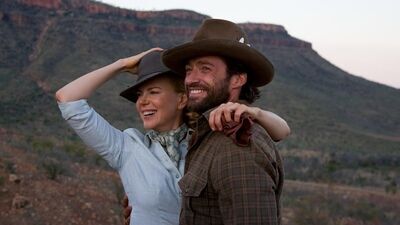Faraway Downs movie review & film summary (2023)
“Faraway Downs” opens with a crawl that informs us about the treatment of Indigenous children in Australia as well as what would happen to part of the region as the Japanese continued their assault after the bombing of Pearl Harbor. It’s not only an acknowledgment that what’s unfolding is on land formed by tragedy but a direct form of foreshadowing that fits Luhrmann’s old-fashioned cinematic sensibility. All the romance that’s about to follow? Tragedy is around the corner.
Luhrmann’s riff on “Gone with the Wind” and “The African Queen” opens in September 1939 with the introduction of Lady Sarah Ashley (Nicole Kidman), whose husband is far away at their massive cattle ranch in Australia that gives the show its new title. She heads there to obtain a divorce from the philanderer, only to find that he’s dead, leaving her in charge of the estate. Of course, the reluctant foreigner is drawn to the land and its people, especially the charming Nullah (Brandon Walters) and the charismatic Drover (Hugh Jackman). The Kidman/Jackman dynamic works in an old-fashioned sense. Of course, Ashley will eventually be drawn to Drover’s gruff exterior. And, of course, Drover will fall for the princess from a far-off land.
However, the old-fashioned aspects of “Faraway Downs” bring with them some anachronistic storytelling elements, with Luhrmann too often portraying Nullah and the other Indigenous people in a magical light. His efforts to improve that aspect here are notable from the beginning, including opening credits designed by Indigenous artists, a new theme from Budjerah, and a new song by Anpuru. Luhrmann said to The Guardian that he wanted to “work with all these young emerging musical artists and graphic artists,” and that’s admirable, even if some of the filmmaking still treats Nullah more like a catalyst for the English aristocrat’s salvation than an actual character himself. Luhrmann reportedly wanted to flip the script of “Gone with the Wind” and tell this story from a First Nations child’s point of view. He doesn’t quite get there, even in this extended edition, but he does come closer than before.
The new construction of “Faraway Downs” is interesting because it’s almost like it could have been designed as a series all along. Hulu allowed Luhrmann to cut the film into six chapters of wildly divergent lengths, with the open and close landing around 45-50 minutes and a pair in between clocking in under 30 minutes. In total, the series runs around 205 minutes once you excise the credits in each episode, so it’s notably longer than the film (about 40 minutes). Still, you never feel the awkward insertion of deleted scenes like in other projects. It’s pretty seamless.
#Faraway #Downs #movie #review #film #summary
